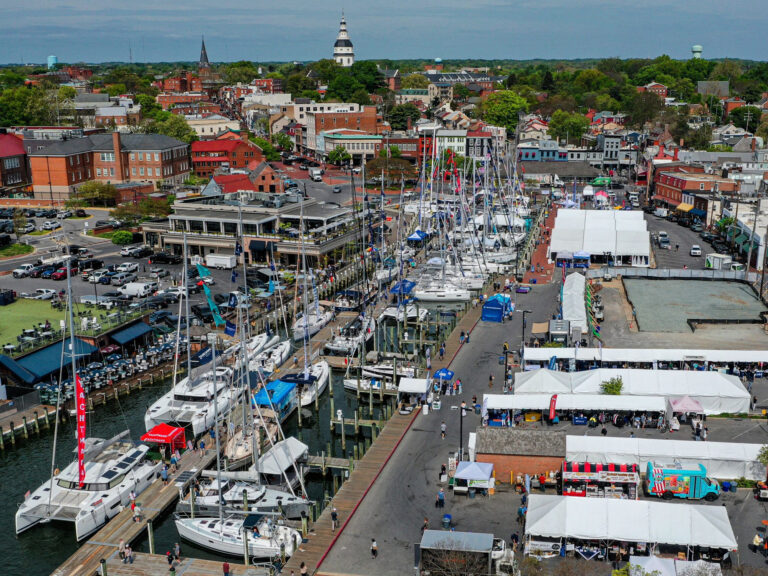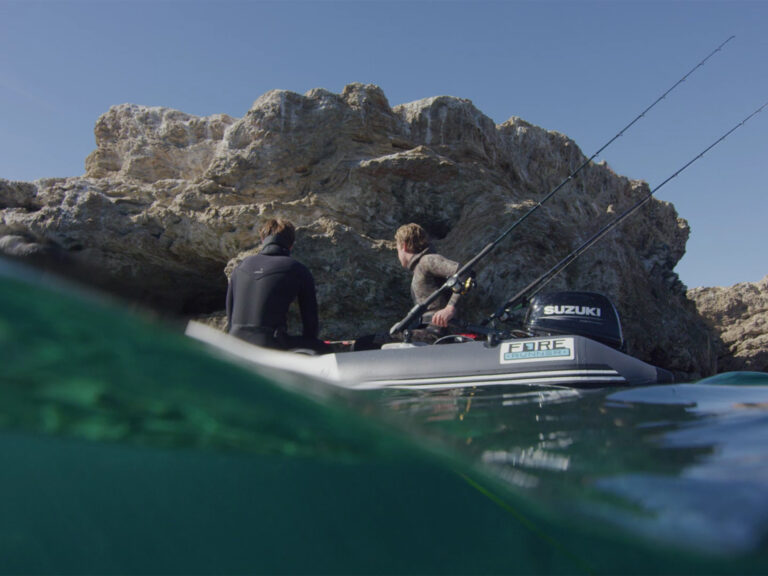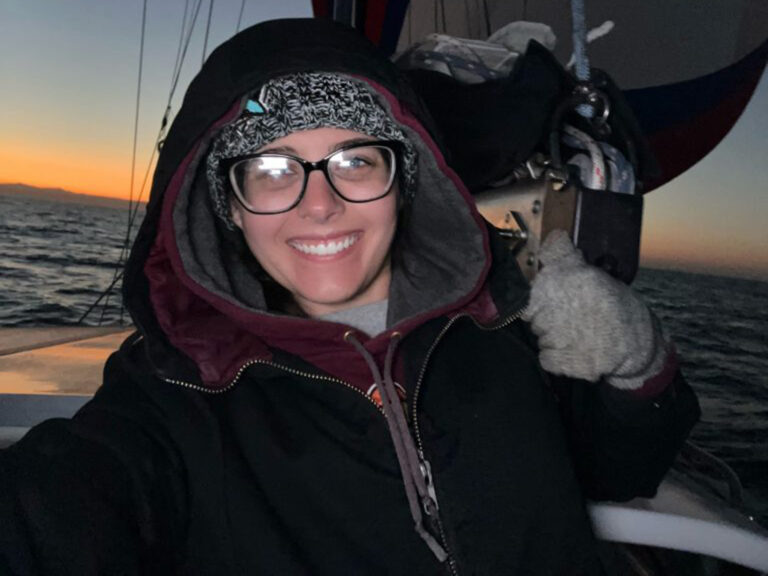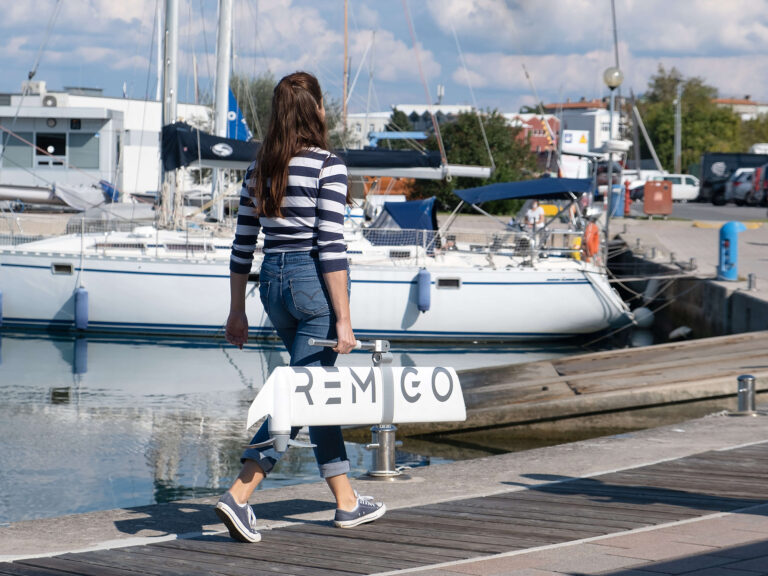When we go sailing, my wife, Lori, and I are reminded how different life is at 60 to 70 mph and how enjoyable it can be at 5 mph, when it doesn’t go by too quickly and when we don’t keep to a schedule. We meet more people, see more of the world, and learn a lot along the way, even if it’s a route we hadn’t planned to take. It’s a relaxing contrast to the rest of our lives — we love cross-country vintage-car races, putting 13,000 miles on a land cruiser to see Alaska, and keeping up with our 22 grandchildren — that alone could drain the juice right out of the batteries. Good thing I have a healthy appetite.
When we really want to get away from it all, sample local food, and see new places, we always come back to sailing. Twelve years ago, we took a boat up the Mississippi; we chartered in the Pacific Northwest; we owned a 28-foot Cape Dory. For the past decade, we’ve sailed Lori J, a 36.5-foot Pearson Pilothouse motorsailer built in 1980, far from our home port of Sturgeon Bay, Wisconsin, and circumnavigated Lake Michigan. But this odyssey would take us much farther.
We’d thought about doing the canals in Europe, but then someone told us about the canal systems closer to home, in the northern United States and Canada. It caught us by surprise — we’d barely heard of the Trent-Severn Waterway, and we were unfamiliar with the Quebec Canal System. We didn’t know that sailboats were typical among the commercial oceangoing ships on the St. Lawrence Seaway. We didn’t know how Lake Huron, our neighboring Great Lake to the east, fit into the whole thing. The more I read, the more I realized that to go from home and back was like making a big triangle. And, for the first time in our lives, we promised ourselves — at age 64 — that we wouldn’t have to hurry to get back home. (Besides the feeling of relief it gave us, we got no complaints from crew. Our faithful cat, Mouser, would continue to set the example of stress-free living by sleeping her usual 23 hours a day.) We decided that when we were ready to come home, we’d leave our boat at one of the many marinas along the way. Later, we’d pick up where we left off. Indeed, by the time we got to Lake Champlain in Vermont, summer had given way to fall and a fire of harvest colors.
Summertime
We set out across the lake early on the morning of July 17, 1998, spotting the tall dunes of lower Michigan by noon. The municipal marina is close to Frankfort, a town known for its nearby Sleeping Bear Sand Dunes, the largest sand dunes in the world — great, shifting mountains of the stuff. Frankfort’s celebrating its sesquicentennial in 2000, so Heritage Days in July are bound to attract lots of folks.
The old Hotel Frankfort serves a wonderful “stone” dinner. We were given plates with a square stone on each, supposedly cut from the Matterhorn in the Pennine Alps on the Italian-Swiss border. The stones are heated in a kiln to 700 F, and we prepared our own pieces of chicken, steak, and shrimp with them — no grease, no fuss.
Next stop was Leland, with its historic Fishtown, a working commercial-fishing village, and the Cove Restaurant on the waterfront. At Charlevoix, we spent a lazy day on sparkling turquoise waters, then headed northwest to Beaver Island and the odd story of American Mormon leader James Jesse Strang, who formed his own sect there in 1847. Strang was the self-declared king of the splinter group, called the Strangites, whom he ruled for two years until he was assassinated.
We’d been to Beaver Island before, for the Fourth of July parade, and had seen how the local floats are greeted by cheering visitors as if they were Rose Bowl Parade productions. This weekend, the docks were a beehive of activity, with boats returning from the Chicago to Mackinac Island race, the oldest and longest freshwater competition in the world. There were only a couple of dozen slips available in St. James harbor, but we counted 51 masts besides all the powerboats. Bacchant, a 64-foot mahogany sloop built in 1936 in Sweden, glided in after taking overall top honors in the PHRF division in this year’s race, the 100th.
Only the roads in St. James itself are paved, but it’s possible to rent a four-wheel-drive vehicle to get to the island’s deserted, pristine beaches, overgrown logging trails, and state-maintained walking trails.
The next day, we left the protected harbor and dockmaster Glenallen Felixson, who’d showed us how to lasso a piling, and headed due east, for Grays Reef light. A squall hit, and we surfed under the mighty Mackinac (pronounced “Mackinaw”) Bridge into Mackinaw City for pizza at Mama Mia’s. Besides great pizza, a museum there documents the construction of the Mackinac Bridge, which connects Michigan’s upper and lower peninsulas.
Next stop, Mackinac Island. With its magnificent Victorian cottages and the venerable old Grand Hotel, which claims to have the longest porch in the world, the island was a trip into another world, and we couldn’t resist. There are no cars here –just horses, buggies, bikes, and hordes of tourists who visit each summer. We hauled our bikes out to pedal the 8-mile perimeter of the island. Of course, the only sensible thing to do after that is have Mackinac Island fudge ice-cream cones. Later, while we dined at Horn’s Gaslight Bar and Restaurant, the piano player belted out ragtime tunes.
Pink Granite Sunset
When we arrived at De Tour Village on the St. Marys River, the first thing we saw was a gleaming 60-foot wooden gaff-rigged schooner on a break from her maiden voyage. From Mackinac, it was less than 60 miles over the northwest corner of Lake Huron.
The next day, we entered the North Channel, rounding Drummond and Cockburn islands and then clearing customs into Canada at Meldrum Bay, Manitoulin Island, Ontario, where the “fresh-baked-goodies-from-local-berries” man had set up shop in his station wagon. He peddled butter tarts, strawberry tarts, pecan rolls, and fresh bread, so we stocked up at bargain Canadian prices.
Arriving in Gore Bay the next day, we heard, “Hi, Lori and Don.” It was our sailing buddies from home. They hosted dinner aboard their 37-foot Tartan that evening. A day later, we were anchored in Benjamin Bay in the Benjamin Islands, the most popular archipelago in the North Channel. With a backdrop of textured pink granite, it was difficult to leave a setting like this — but that was the only way we’d get to the ice-cream store in Little Current, where we stayed for the night at the government dock. After a quick stop along the 500-foot wharf in Little Current, we headed out through the railroad swing bridge and anchored in the glassy water of Browning Cove at Heywood Island.
Just to the north is West Mary Island, where the wreck of Indio, a lumber schooner, is still visible from the surface. Launched in 1899, it was built as part of the rebound of sailing ships in competition with early steam-powered freight vessels for a piece of the massive Great Lakes trade in grain, timber, coal, and oil. It burned and sank in 1928. Though it would be a bit cold without a wet suit, I managed to get some underwater pictures with a mask, snorkel, and disposable waterproof camera.
It was as if a mirror had been held up to us as we made our way east through Lansdowne Channel. Headed from the opposite direction was our identical sister ship, Carrie D. We turned around and, in light air, raced her and a 37-foot cutter-rigged sloop to Frazer Bay. As luck had it, we won, and I quickly tried to come up with some impressive racing strategy to account for it.
At Killarney, the power was out and the gas pumps weren’t working, so some folks were in for a longer stay than they’d expected; fortunately Lori J already filled up. In the quaint, rugged village, we visited the Killarney Mountain Lodge and feasted on fish and chips.
The anchorages along the way to Byng Inlet were the most beautiful we’d ever seen. Multihued rock formations, gentle rapids, and windswept trees surrounded us with a kaleidoscope of colors.
The Captain’s Quarters offers a free tie-up when you buy dinner at the Sawmill Lodge in Byng Inlet, and it doubled our enjoyment of the mouthwatering fresh Georgian Bay walleye. While we were there, we had Wright’s Marina service our 3-horsepower outboard with a carburetor-jet transplant and new plugs. In no time, it ran like a champ.
Over the VHF the Coast Guard was broadcasting that it was raising a new, 55-foot motorboat that hit rocks and sank while going through Hangdog Reef north of Parry Sound. That’s right where we were headed, to gunkhole along the 30,000 islands between the sound and Penetanguishene to the southeast. Supposedly, this region has the highest concentration of islands in the world. Was this too risky a plan? Mouser didn’t look worried, so we decided we wouldn’t worry, either. Passing Rogers Island, we anchored off Alexander Passage and waited a day for wind and waves to subside.
On a calm, clear morning, Hangdog Reef turned out to be no problem; we felt confident we could “Round the Horn.”
We made it to Parry Sound Government Dock, where we enjoyed watching two square-riggers exchange student crews. Radar guided us through the mist to Honey Harbour, the headquarters of the Georgian Bay Islands National Park. With this landfall, we completed the “inside passage” and proceeded to Penetanguishene, where the British had established a naval base and military garrison in the 19th century. At the dock was Tecumseth, a 124-foot schooner, and Bee, a 79-foot schooner, which conduct sailing programs in summer. That night, a performance of Charlie’s Aunt by a local troupe initiated us into our first evening of theater by dinghy.
Rounding Sucker Creek Point, we went to Wye Heritage Marina near Midland, where a crane removed our 50-foot mast and we installed our homemade, 14-foot spar for clearing fixed bridges. We left the mast, boom, and sails with Wye for a year; the total cost, including $300 to remove the mast, was $500.
Zigzagging Playground
We could have made it through the Trent-Severn Waterway, a 240-plus-mile system, in a week, but we took 15 days and could have taken twice that because there was so much to see and do. The waterway, which opened in 1920, zigzags through central Ontario, linking the Bay of Quinte with Georgian Bay via a series of 43 locks, 125 dams, and 30 miles of manmade canals. Though its 19th-century planners predicted the system’s greatest value would be as a commercial-transportation route, it’s evolved into a recreational platform, aside from its role in the production of hydroelectric power for the city of Ontario and for Trent University in Peterborough, Ontario.
For Lori J, the highlights of her Trent-Severn travels occurred at Big Chute Marine Railway, where she floated in a partially submerged car while cradled by slings, and at the Kirkfield Lift Lock at Lake Simcoe. At Kirkfield, a hydraulic mechanism with a monstrous ram, a type of piston hooked to a similar setup right alongside, lifted Lori J 49 feet up in a bathtub of water. One foot of extra water in the top lock chamber weighs 144 tons more than the other one, so when it descends, it forces the other one up. This brought us to Balsam Lake, the highest point of the waterway. It was all downhill from there, with the small exception of an aspect of Lori’s daily maintenance, which involved cleaning the raw-water strainer, as weed growth was heavy.
In Fenelon Falls, we visited an English china shop, and at Lovesick Lock, we tied up for a meal at the Lovesick Cafe. Thunderstorms rolled in at Burleigh Falls, so Lori made chocolate-chip cookies and focaccia. Our approach to the city dock at Lakefield was very undignified, thanks to strong winds. Finally, we got in and went for an evening stroll.
In Campbellford, Charles Mahoney, 80, and still riding despite ill health, has a collection of fine vintage Indian motorcycles at his home. We took his 1940 four-cylinder and a 1953 V-Twin out for a ride to enjoy the leaves turning red, before carrying on along the waterway to the Fraser Park Marina in Trenton.
We followed the Bay of Quinte through to Deseronto and the heavily forested passage of Picton Bay. Anchored at Kingston, we heard the rumble of thunder, spied a few waterspouts, and moved to the docks at Confederate Basin. Ashore, a visit to the Pump House Steam Museum, a tribute to the history of steam power that’s part of the Marine Museum of the Great Lakes, was a real treat. The steam museum is restoring s/l Phoebe, a 48-foot steam launch built in 1914, and features a range of technology subjects at its library.
St. Lawrence Link
You can sail from Duluth, Minnesota, to the Atlantic Ocean, a distance of more than 2,300 miles, thanks to the St. Lawrence Seaway system, which gives commercial traffic and recreational vessels access to 95,000 square miles of navigable waters and includes some of North America’s largest ports. As the only natural outlet for the Great Lakes, the Seaway discharges at the rate of 234,000 cubic feet per second. Although the average current is 1 to 3 knots, in narrow passages there can be up to a 9-knot current. If we’d tried going against that at Lori J’s full speed, we’d be doing 2 to 3 knots — backwards.
Starting in the Thousand Islands lakes region, where the St. Lawrence is about 15 miles wide and accommodates 1,800 landmasses, some as small as points of rock and others as large as several square miles, we decided to take our time. On the U.S. side, we tied up at the town docks near the Antique Boat Museum, which features 200 antique inland recreational craft, from graceful sailing skiffs to vessels like Pardon Me, at 48 feet the largest mahogany runabout we’d ever seen.
Ten miles northeast, we docked at Heart Island in Alexandria Bay to visit Boldt Castle and learn more about its famous love story. In 1900, George Boldt, who launched his real-estate fortune as proprietor of the Waldorf-Astoria Hotel in New York City, started building a full-size replica of a 16th-century Rhineland castle as well as a large yacht house to show the love he felt for his wife, Louise. When Louise died suddenly four years later, work on the six-story, 120-room castle, which had cost $2.5 million, stopped, and Boldt never went back to Heart Island. The castle remains unfinished to this day, with revenues from weddings, cocktail receptions, and tourist visits helping the Thousand Islands Bridge Authority, which acquired the property in 1977, to complete construction and renovation.
Near Morrisburg, Ontario, we visited Upper Canada Village, a re-creation of a riverfront town that depicts life as it was before work on the seaway project in the 1950s permanently submerged the communities between Iroquois and Cornwall.
By the time we got to Eisenhower Lock, the wait was four hours so large, oceangoing freighters could get through. After a shorter wait at Snell Lock, we overnighted at Cornwall, Ontario, bucking a 3-knot current into the marina.
The next day, unable to set a good anchor in the wind and the current near the opening of the Canal de la Rive Sud, we headed for the Royal St. Lawrence Yacht Club on Lac Saint-Louis. The buoys on the course make a zigzag pattern, so ahead of us we saw a field of green and red; radar in broad daylight helped us identify them. Our first visit to the marina was on the house.
Cultural Fusion
The island-city of Montreal, the second largest French-speaking city after Paris, appeared in all its cosmopolitan beauty. Here, ultramodern, all-glass skyscrapers mix with countless old church spires, a melting pot of different times sitting at the bottom of a dormant and well-worn volcano, the Mont-Royal. At the rounded top of the mountain sits a massive cross, a reminder of Quebec’s religious ties to the Vatican. We stopped at the marina at Longueuil, right across from Montreal’s east-end harbor, easily identified by its numerous grain silos. We caught a ferry right across from our marina to Vieux-Montreal’s cobblestone streets, horse-drawn carriages, and old French and English buildings lining the narrow streets. The Quebecois enjoy French culture, English traditions, and the American lifestyle; they’re as multicultural as their city. Across from a cathedral is a Greek restaurant; around the corner, a French cafe; behind it, an Italian bakery.
After spending the night at the Parc Nautique de Sorel, we left the St. Lawrence Seaway and headed south on the Richelieu, a narrow river with muddy banks that meanders through farm land. It’s lined with farm houses and old, French-style houses with attic windows, stone chimneys, and bright colors. At one point, the river turns into shallow rapids. Just north of McMasterville, the approach to the Canadian Pacific swing bridge is narrow, and the current was against us at 4 to 5 knots. We slowly crawled through; in the main river, the current is again less than 1 knot.
Return Stateside
The Chambly canal, a system for pleasure craft only that bypasses a long stretch of rapids, took us right past people’s front gardens. Families were out picnicking, and kids were fishing for catfish from the canal walls. The old locks are hand operated, and the lock tenders, despite the language difference, were friendly. As we continued to head south from the flat lands, the Adirondack Mountains began to rise and frame Lake Champlain, making it look like a giant fjord. We crossed the border and followed an accepted procedure for clearing U.S. customs at Rouses Point. Once we settled in at one of the several marinas in the area, a telephone call brought the inspector to us.
On our way to Plattsburgh, New York, we dropped the hook within feet of the forested shore at Deep Bay. Fantessy, a canal boat that we saw frequently along the way, anchored near us, creating an atmosphere so appealing that we stayed several days. The shoreline is undeveloped; ashore, there are well-groomed hiking trails. When a south-southwest wind felt uncomfortable, we weighed anchor and headed for the total protection of the man-made basin at Marina Champlain. There, friendly folks took us shopping and joined us for cappuccino and a game of Sequence.
A course past Cumberland Head, through the narrows between South Hero and Providence islands, and past the abandoned railroad causeway brought us to Burlington, Vermont. The small, trendy city is as renowned for its socialist congressman, Bernie Sanders, as it is for being the home to Ben & Jerry’s first ice-cream parlor, which was converted from an old gas station. We rented a car so we could drive to the mountains and see the fall colors. We photographed some of the state’s beloved covered bridges and had afternoon tea at the Trapp Family Lodge of The Sound of Music fame. A week easily slid by amid the fresh air of the mountains, the brilliant fall foliage, and the pleasures of Burlington, which charmed us with its wide pedestrian walkways and microbrewery beers served in outdoor cafes.
It was the end of our 1,210-mile American-Canadian sojourn. We’d done more than we’d ever hoped to and learned more than we could have imagined. We’d seen a part of the continent from the inside, and we felt proud of the accomplishment.
————————————————————————
The Johnsons hauled their boat in Charlotte, 15 miles south of Burlington, rented a car, and drove home to Sturgeon Bay in two and a half days — the first half of the trip took them about two and a half months. A year later, sustaining their habit of packing in the miles, the Johnsons drove a 1929 Model A Ford Speedster from Georgia to California in the Great Race, then returned to Charlotte and Lori J, which they took through the New York state canal system to the Erie Canal, Lake Erie, the Detroit and St. Clair rivers, then back through Lake Huron and Lake Michigan to Wisconsin and home.
————————————————————————
Charts, Guides, Contacts
For complete lists of the many charts for the well-documented regions the Johnsons sailed on this leg of their trip, consult:
Catalogue No. 4: Great Lakes and Adjacent Waterways; National Ocean Service, National Oceanic and Atmospheric Administration, Distribution Division (N/ACC 3), Riverdale, Maryland 20737-1199; 301-436-6990 or 800-638-8972
Catalogue of Nautical Charts and Publications: Great Lakes and St. Lawrence River, including Major Lakes and Rivers in Ontario and Manitoba; Canadian Hydrographic Service, Distribution Office, Dept. of Fisheries and Oceans, 1675 Russell Rd., P.O. Box 8080, Ottawa, Ontario, Canada K1G 3H6; 613-993-0999; www.chshq.dfo.ca
**Guides
Among the many publications available about the Great Lakes, Canadian canals, and other inland waters, Don and Lori consulted:
Ports Cruising Guide to Georgian Bay, The North Channel, and Lake Huron (Ann Vanderhoof, ed.; 1997; Ports Cruising Guides, $35; 416-691-0488)
Ports Cruising Guide to Lake Ontario and the Thousand Islands (Ann Vanderhoof, ed.; 1997; Ports Cruising Guides, $35; 416-691-0488)
Ports Cruising Guide to the Trent-Severn Waterway and Lake Simcoe (Ann Vanderhoof, ed.; 1995; Ports Cruising Guides, $25; 416-691-0488)
Cruising Guide to Lake Champlain by Alan and Susan McKibbon (1997; Lake Champlain Pub. Co., $35)
Cruising Guide to the NortheastÕs Inland Waterways by Bill Marina and Tom Rumsey (1995; Tab Books, $40)
Small Craft Guide: Trent-Severn Waterway written and published by the Canadian Hydrographic Service (7th ed.; 1989; Fisheries and Oceans, CAN$18.50)
Trent-Severn Waterway: Boating and Road Guide by R. Lyons (2nd ed.; 1998; Lyons Den Enterprises , CAN$10)
The Great Circle Route by Skipper Bob (2000; Skipper Bob, $18; email SkipperBob@worldnet.att.net). Highly recommended.
St. Lawrence Seaway Pleasure Craft Guide by the St. Lawrence Seaway Management Corp. (free; see below for address; email marketing@seaway.ca)
Don used Richardsons Chartbooks and Cruising Guides, available for each of the Great Lakes as well as the Hudson River and Adjacent Waterways (Richardsons Publishing, 88 Hatch St., Suite 403, New Bedford, MA 02745 (800-873-4057; email richcharts@aol.com).
Contacts
Use these contacts for canal and waterway charts, guides, fees, facilities, and locking procedures in Canada and in the United States:
Friends of the Trent-Severn Waterway (P.O. Box 572, Peterborough, Ontario, Canada K9J 6Z6; 705-742-2251; 800-663-2628, fax 705-750-4816; email ftsw@ptbo.igs.net; websites include www.ftsw.com;http://collections.ic.gc.ca/waterway/; http://ptbo.igs.net/ftsw;http://parks canada.pch.gc.ca)
St. Lawrence Seaway Management Corp. (202 Pitt St., Cornwall, Ontario, Canada K6J 3P7; 613-932-5170, fax 613-932-5037; www.seaway.ca)
Historic Canals in Quebec (1889 Perigny Blvd., Chambly, Quebec, Canada J3L4C3, http://parcscanada.risq.qc.ca/canaux/canal-de-chambly)
Great Lakes Cruising Club (312-372-2344, fax 312-372-2388; email glcclub@aol.com)
New York State Canal Corporation (P.O. Box 189, Albany, NY, 12201; 800-422-6254; www.canals.state.ny.us)
Transport Canada (100 Front St. South, Sarnia, Ontario, Canada N7T 2M4; 519-383-1826)
Ontario Marina Operators Association (Suite 49, 2 Poyntz St., Penetanguishene, Ontario, Canada L9M 1M2; 705-549-1667; fax 705-549-1670; www.omoa.com)
Fireworks, Regattas, Festivals
Dont miss:
Heritage Days; July 14-15, Frankfort, Michigan (231-352-7251; www.benzie.com/frankfort)
Chicago to Mackinac Island race, July 22-24 (800-454-5227; www.mackinacisland.com or http://chicagoyachtclub.com)
36th Annual Antique Boat Show and Auction; August 4-6, Antique Boat Museum, Clayton, NY (315-686-4104; www.abm.org)
Millennium Fireworks Display; August 18, Boldt Castle, Alexandria Bay, NY(315-482-9724 in season; 315-482-2501; www.boldtcastle.com)
Antique Car Day; August 20, Upper Canada Village, Morrisburg, Ontario, Canada (800-437-2233, 613-543-3704; www.parks.on.ca/village/)







